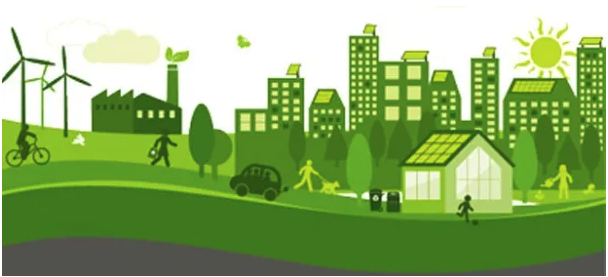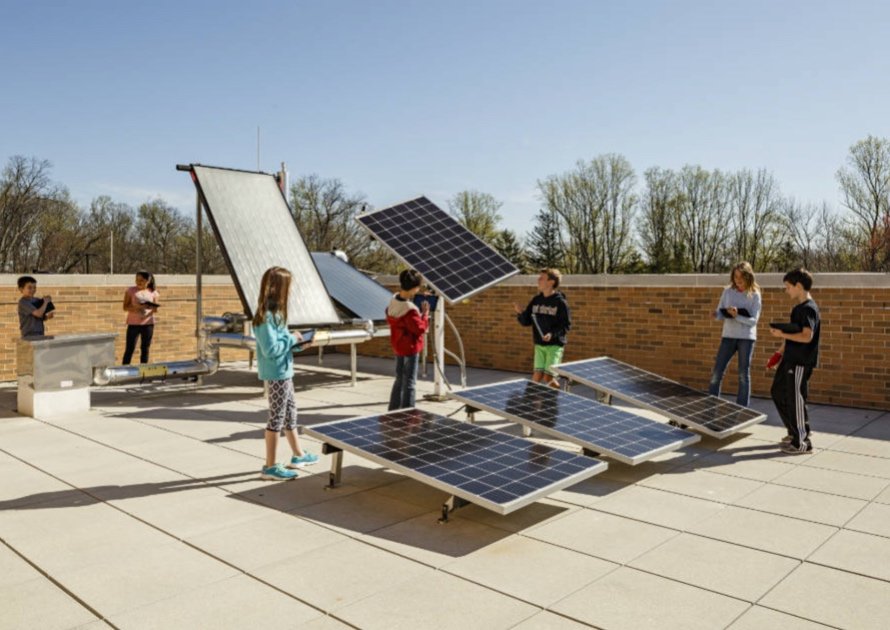Sustainability and Clean Energy Across Industries: Proposing a ‘Green New Deal’ for Various Professions
After a 35-day shutdown, the new Congressional class has finally been able to get to work on their campaign promises. While the existence of a shutdown does not affect overall electricity demand in the Washington DC area, according to previous Chester Energy and Policy analysis, the new crop of lawmakers finally get to work bring cause for excitement in the energy sector. Namely, some notable candidates who won last November campaigned strongly on concerns about climate change and calls for clean energy policy, and they’re looking to deliver on those promises with the high-profile Green New Deal.
Source: Los Angeles Times
Voter focus on energy and climate policy seems like it just might for the first time have the momentum for real movement. While some reasons persist for restrained expectations on the climate policy that will come from it, the proposed Green New Deal has taken activists, politicians, and the energy/climate communities by storm. Some of the broad tenets of the Green New Deal include:
Committing to net zero greenhouse gas (GHG) emissions within 10 years;
Eliminating pollution and GHG emissions “as much as technologically feasible;”
Upgrading to smart grids;
Upgrading all buildings to maximize energy efficiency;
Investing in infrastructure, public transit, and high-speed rail;
Investing in new energy technology R&D;
Enacting trade rules that increase jobs but don’t transfer pollution or emissions overseas, and much more.
While only time will tell if Congress will walk the walk (though be sure to contact your representatives– policy isn’t just a spectator sport!), I thought the idea of a Green New Deal was interesting as a landscape-shifting paradigm in public policy. But that just got me pondering the question: what would a similar swing in momentum translated to real-life action look like in various other fields? The Green New Deal deals largely with the expected industries, such as electric power industry, manufacturing, and transportation. But what would a Green New Deal look like in industries you’re less likely to think about in that way– a Green New Deal for education? Or what about a Green New Deal in sports?
To answer these questions, I reached out to green and sustainability experts in a number of different fields to get their perspective on what a Green New Deal in their industry would look like. The answers received were insightful and thought-provoking, but most of all they demonstrated how much work can be done in various professions– you need not wait for politicians to make these decisions, you can push for action in whatever field may be your forte.
The Green New Deal for SPORTS
Source: Ensia
The first influencer of change I thought to reach out to for this exercise was Lew Blaustein, writer behind the Green Sports Blog. I had the pleasure of interviewing Lew last year about his work in the intersection of sustainability and sport, so I knew right away he would have some great suggestions about how athletics at every level could integrate much-needed actions on energy.
Lew thinks the main focus in a sports-related Green New Deal should be on using the platform of sports to communicate important green and climate messages to fans.
Leagues and other mega-sports rights holders (such as FIFA and the International Olympic Committee) must demand that networks who win broadcasts, cable, and streaming rights must air climate change and/or environmental public service announcements (PSAs) during events like the Super Bowl, March Madness Final Four, Olympics, World Cup, and more.
Any teams, leagues, or other rights holders who do broadcast PSAs for fighting climate change receive a tax break.
Stadiums and other sporting venues would receive tax breaks or subsidies for having vegan concession stands, a designated number of electric vehicle (EV) charging stations, and other important green measures.
Fans who travel to games via mass transit or drive EVs or hybrid cars would get a rebate, which would be paid for from parking revenues. Fans who get to games by walking or biking could also qualify for these rebates.
This combination of public messaging and financial incentives, in Blaustein’s opinion, would make for the basis of a greatly effective and important Sports Green New Deal, and perhaps this model could be implemented for actors outside the world of sports, too?
The Green New Deal for HIGHER EDUCATION
Source: Georgetown University
Institutions of higher education– colleges, universities, trade schools, and the like– are critical parts to the world’s growing economies in both industrialized and developing nations. Ensuring these important epicenters technological advancement and overall progress embrace sustainability, clean energy, and the fight against climate change is critical. These goals are championed by the Association for the Advancement of Sustainability in Higher Education (AASHE), meaning this group was the perfect representative to ask about a Green New Deal in Higher Education.
Julian Dautremont, Director of Programs at AASHE, responded and was kind enough to provide some input on this hypothetical, noting the following:
Higher education has an essential role to play in meeting the goals of a Green New Deal. For example, it can provide the education and training to prepare displaced workers and new graduates for green jobs. It can provide the research necessary to develop new renewable energy and carbon removal technologies. It can provide a supportive test bed for piloting new sustainable technologies on campus.
Many leading higher education institutions are doing some of this kind of work already but for the sector as a whole to fulfill its transformative potential, significant government investment will be needed. Funding is needed to facilitate the development of new courses and educational programs will be needed. Funding is needed to facilitate the development of new courses and educational programs as well as to expand research. On the facilities side, we would especially like to see additional resources flow to help under-resourced institutions and help them improve the efficiency of their facilities and take advantage of opportunities to deploy renewable energy on campus.
Higher education, as shown by this answer, can play a unique role by not only embracing Green New Deal goals for its own sake, but also enhancing the viability and likelihood for success in grander Green New Deal goals across the country and the world.
The Green New Deal for MOTION PICTURES
Source: Vancouver Courier
While scientists and activists work tirelessly to study and assess the pending climate change crisis, an argument could be made that it isn’t until these ideas permeated the motion picture industry that the mainstream public really took notice. An Inconvenient Trutheffectively spread the message to a wider population who had been largely turning a blind eye, while celebrities in the movie industry such as Leonardo DiCaprio and Harrison Ford have found they can leverage their fame to speak out on behalf of important sustainability issues.
Zena Harris is president of the Green Spark Group, a sustainability consultancy that serves the motion picture industry to develop sustainability practices on movie sets, in the corporate strategy of production studios, and more. As such, she was the perfect person to outline what a Green New Deal might look like for the film industry, and she was not short on ideas.
Noting that the motion picture industry is a truly multi-disciplinary one (e.g., on the production side alone there’s construction, transportation, food services, human resources, finance, manufacturing, and more), Zena suggests that TV and film are ideal candidates to embrace sustainability from top to bottom. If she could snap her fingers and get what she wanted (a more benevolent version of 2018 film icon Thanos), Zena would implement the following:
Education on climate change and related sustainability production practices for everyone in the industry, because knowing the why behind sustainability most often leads to shift in behavior in practice (in particular, collective action from local film communities are often the best models to influence change).
Modeling sustainable production practice in all media forms to demonstrate the type of world we want to live in (e.g., why do we show plastic cups on screen in commercials that are about insurance when it would be just as easy to show reusable dishware?).
Consistent implementation and tracking of sustainable production practices and impacts behind the scenes on production in all departments, including use of low-impact (e.g., organic or post-consumer recycled) materials and reduced consumption– from materials for set walls to meat in catering.
Implementation of zero-emission, alternative power technologies for both vehicles and generators (such as Portable Electric battery power stations).
More dialogue across the industry and with the public about sustainability on the set and beyond– if filmmakers aren’t talking about these issues then they haven’t done their job as storytellers. See recent reminders of how the motion picture industry can influence cultural change in #MeToo, #StopSucking, and #TimesUp. Zena suggests a #SustainableProduction movement to push culture closer to the tipping point for widespread action.
Ultimately, Harris says, she envisions a cultural shift towards a low-carbon, circular, and just economy. The sustainability message can be amplified behind the screen and on the screen. She notes:
In the motion picture industry, we can create anything– vast worlds, virtual reality experiences, stories that grab at hearts and minds and put them on the screen. We have the power to reach in and pull emotional reactions from our audiences. I believe the motion picture industry can accelerate sustainability faster than any other industry if we put our minds and our creative abilities to it. We’ve got the tools, we have our script, and we know what we need to do– we just haven’t stepped up to the mic yet and cranked up the amplifier.
The Green New Deal for the INTERNET
Source: Shutterstock
For any widespread activist push, the internet has become an indisputable and irreplaceable tool for spreading the message, conducting research, fostering education, and many other aspects of affecting change. But the internet is not only a tool to disseminate climate and clean energy activism, but it also represents an avenue where potential progress can be made.
To find out what a Green New Deal for the internet might include, I reached out to Tim Frick, CEO of Mightybytes and author of Designing for Sustainability: A Guide to Building Greener Digital Products and Services. Being ingrained in the world of energy-conscious digital products, the answer Tim ended up brainstorming inspired him so much that he ended up writing an entire blog post of his own on the topic! The main tenets of Tim’s Green New Deal for the internet that he says today is the largest coal-powered machine on the planet includes the following:
Green internet infrastructure, including powering all data centers with renewable energy and ensuring they run efficiently through financial incentives, public reporting on energy mix and clean energy efforts, and industry regulations. Tim notes efforts could be bolstered by a carbon tax bill, open APIs and datasets in the relevant sectors, and more.
Increased sustainability UX practices, since large amounts of energy are wasted using websites not optimized for devices, closing pop-up windows, digging for buried information on websites, and generally slow and unusable websites because “all those pixels require energy to run.” Progress can be made through digital sustainability standards and sustainable web design jobs.
Circular economy and using internet-enabled technologies to foster such principles, including in the sectors of waste management, materials processing, modular production, and enhanced connectivity.
I’d recommend reading Tim’s article in full, but his closing passage sums up the idea well:
While a Green New Deal offers great potential to create jobs and move us more quickly toward a clean economy, it’s not likely that internet-related legislation will be a part of it, however nice that might be. Digital sustainability is barely on our industry’s radar, let alone policymakers. There is much work to be done.
The Green New Deal for CHILDHOOD EDUCATION
Source: Inside Climate News
Returning to the world of education, but this time for early education and childhood education, I spoke with Bobby Donohue, the man behind Planet Bonehead, an educational series that uses “educational documentary videos to teach kids about environmental issues, and show them the work real companies, entrepreneurs, and scientists are doing to help our planet” to prepare children today for the world of tomorrow.
When pressed on what a Green New Deal for childhood education would look like in his view, Bobby noted that it would have to include all the main principles he follows in creating his show:
Teach kids about environmental issues without ‘doom or gloom’ or a political spin.
Empower kids by suggesting ways they can make a difference themselves at home and at school.
Inspire kids to be a bigger part of the solution when they grow up by introducing them to some of the current industries working today. While kids today know plenty about Silicon Valley companies, they barely even know that green tech exists.
Introduce the concept of social responsibility early and teach kids how to be global citizens.
Teach entrepreneurial skills in school so kids are better prepared for the realities of the workforce awaiting them, whether it’s in environmental fields or not.
If curriculum for elementary and middle schools incorporated these principles behind a childhood education Green New Deal, the future of clean energy could shine even brighter.
The idea behind a Green New Deal aims high and really seeks to implement changes that will rebuild the economy in a green and sustainable manner. While Congress’s Green New Deal might falter or stumble along the way, the exercise is still valuable to push the conversation and the focus of relevant industries in the right direction. By setting ambitious goalposts, hopefully at least moderate headway can be made. Similarly, all of these leaders I spoke with are doing great work by setting aspirations high, pushing for them as hard as they can, and achieving incremental but invaluable progress.
What about other industries– do you think a Green New Deal would be necessary or successful in fields not discussed above? Do you have suggestions for what those goals would be? Let me know in the comments below or on Twitter!







